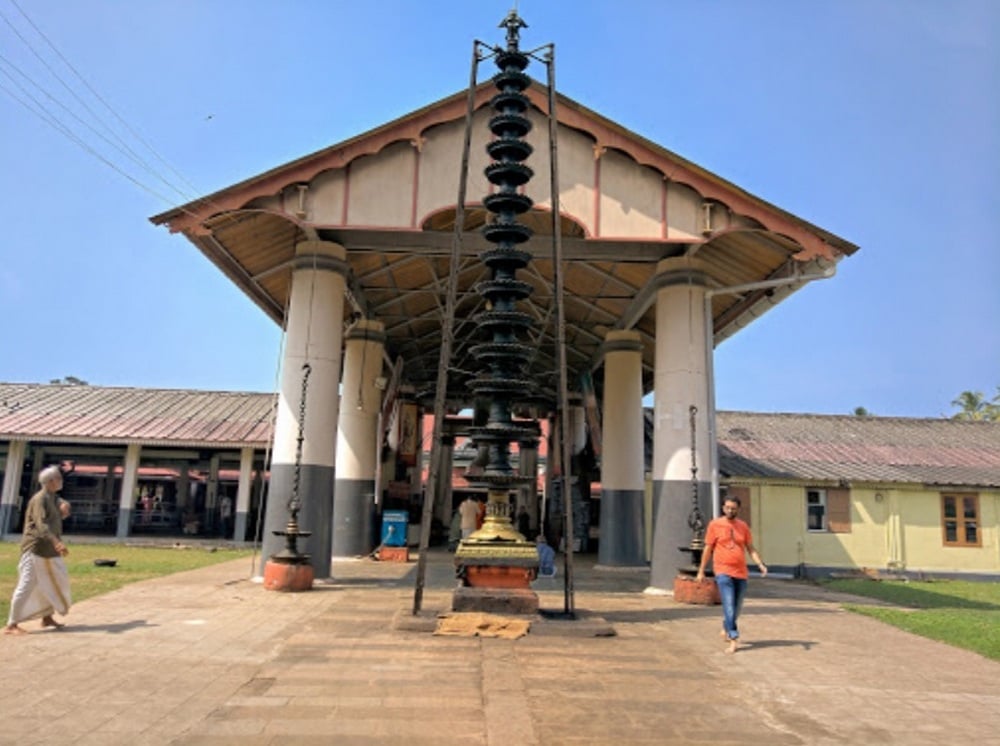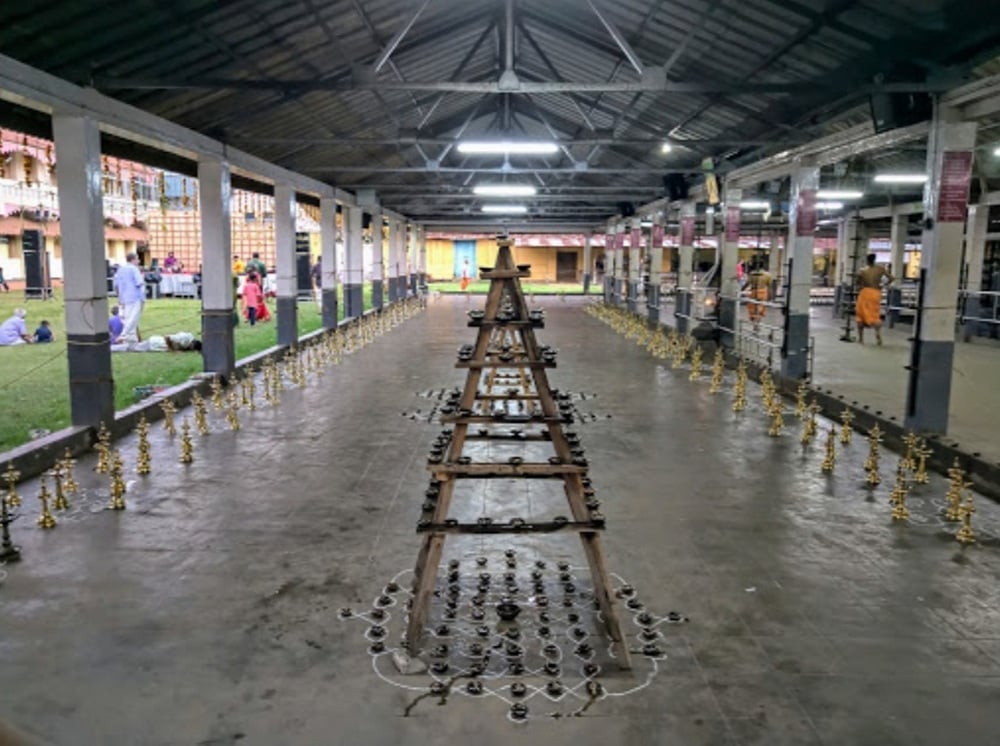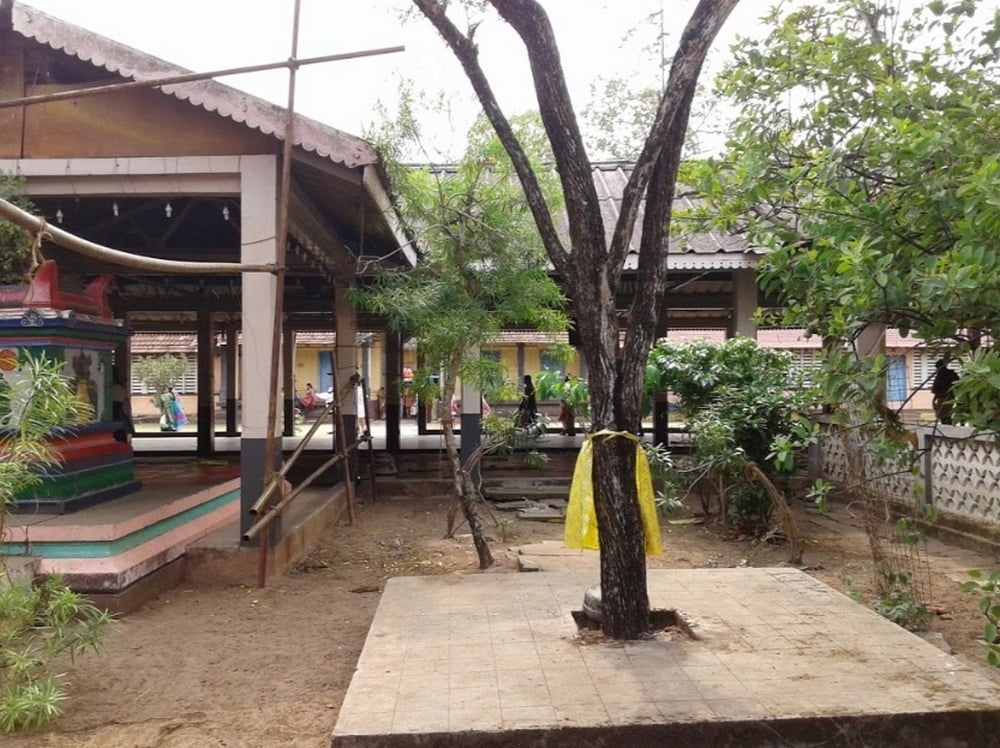Udyaneshwar Siva Temple, dedicated to Lord Shiva, is located on the northeastern side of the Theppakulam of Cochin Thirumala Devaswom.

According to legend, the massive lingam of the temple originally belonged to the ancient Thrikkannamathilakom Temple, situated about thirteen miles from Irinjalakuda in Thrissur District. Thrikkannamathilakom later gained prominence for housing a revered Shiva temple, to which other significant temples of Kerala, such as Guruvayur and Koodalmanikyam, were once believed to be subordinate.
It is said that the lingam of the Mathilakom temple was installed by Sage Parasurama for the spiritual benefit of 64 Namboothiri Brahmin villages.
The temple's boundary wall extends to Theppakulam in the north and Naranjerikulam in the south. Theppakulam is a scenic pond filled with lotuses of various colors, where the priests perform their daily ritual baths. To the west of the temple lies another pond, Chempalikulam. The early rulers of Kerala, the Perumals, are believed to have held their parliamentary meetings on the upper floor of the tank shed at Chempalikulam.
A distinctive ritual at the Udyaneshwara Temple is the daily offering of nivedya, which is prepared using 101 measures (paras) of rice. Historically, the management of the Mathilakom Temple was entrusted to two Nair families, Thekkedath and Vadakkedath. When they assumed full control of the temple, they planned to construct six additional walls around the temple to allocate different enclosures for people of various castes. The outermost wall, however, was designed to extend into the sacred land (sanketham) of the Brahmins of Irinjalakuda gramam, leading to strong protests from the Namboothiris.
Despite their resistance, the protests were suppressed, and those who lay in the trenches as an act of defiance were brutally beaten. Some were even buried alive under the temple's foundation. With no other recourse, the Namboothiris decided to conduct a powerful homa (fire ritual), which was attended by Brahmins from across Kerala. As the Namboothiris gathered for a grand feast, one among them stood up and urged everyone not to partake in the meal until their objective was achieved. Immediately, they encircled the sacrificial fire pit and, amidst powerful chants and prayers, cast all the prepared food into the flames, seeking divine retribution against their adversaries.
Following this, they undertook an intense 41-day fast, sustaining themselves solely on fruits. Their prayers bore fruit as the Nair chieftains soon turned against each other, leading to the downfall of the two Nair families and the decline of the legendary Mathilakom Temple. Considering the cursed village unfit for habitation, the Namboothiris abandoned it, leaving the temple to fall into ruins.
In the 14th century, the Mathilakom area came under the control of the Zamorin of Calicut. However, in 1717 AD, the Dutch acquired sovereignty over the land from the ruler of Calicut.
Dutch plundered the temple, moving the sacred Shiva lingam and several relics to their headquarters in Fort Cochin. The massive lingam was repurposed as a mooring stone on the seashore to secure lighters carrying cargo to ships. Following the Dutch surrender to the British in 1795, the Konkani community in Cochin purchased the sacred Shiva lingam and decided to enshrine it at a site northeast of the Theppakulam of Cochin Thirumala Devaswom, in the midst of a garden.
Due to the sheer size of the lingam, which is said to be 21 feet in height, constructing a temple large enough to accommodate it was impractical. Consequently, the lingam was partially installed underground, with only about 4.5 feet visible above the surface. Notably, the markings on the lingam bear a striking resemblance to those found on a lingam at the renowned Perur Shiva Temple in Tamil Nadu.
Unlike most Shiva temples, where the deity typically faces east, Lord Udayaneshwara is uniquely positioned facing west, towards the Arabian Sea.
The temple follows a tradition of offering nivedyam similar to that of Lord Venkateswara at the Thirumala Temple in Cochin. Every Monday, the lamp post in front of the temple is ceremoniously illuminated. The grand Mahashivaratri festival, held in February or March, is the temple’s most significant celebration. Other important rituals include Rudrabhishekam, Pushpanjali, Rudra Havanam, Bilvarchana, and Chandana Lepanam.
A unique belief associated with the temple is that unmarried women can attain suitable life partners by performing the Swayamvara Pushpanjali ritual. Another significant event is the Aarattu festival of the Thirumala Devaswom, during which the deity's idol is taken in a grand procession on a horse-drawn chariot from the main temple to the Udayaneshwara Temple. Here, Lord Shiva participates in the symbolic Palli Vettai (sacred hunt) before the deity is returned to the main temple.
ശ്രീ ഉദ്യാനേശ്വര ശിവ ക്ഷേത്രം
കൊച്ചി തിരുമല ദേവസ്വത്തിന്റേതായ കിഴക്കേ കുളത്തിന്റെയും വടക്കുകിഴക്കേ ഭാഗത്തെയും മതിൽക്കെട്ടിനുള്ളിൽ ശിവനെ പ്രതിഷ്ഠിച്ചാണ് ഉദ്യാനേശ്വരക്ഷേത്രം സ്ഥാപിക്കപ്പെട്ടത്. ക്ഷേത്രപരിസരത്ത് പഴയ കാലത്ത് ഒരു ഉദ്യാനം ഉണ്ടായിരുന്നതിനാൽ, ഈ ശിവ പ്രതിഷ്ഠയെ “ഉദ്യാനേശ്വരൻ” എന്ന വിശേഷണത്തോടെ അറിയപ്പെടാൻ തുടങ്ങി.
ഈ ശിവലിംഗത്തിന്റെയൊക്കെ അതിപൂർവ സവിശേഷതയാണ് അതിന്റെ പ്രധാനഭാഗം ഭൂമിക്കടിയിലായിരിക്കുന്നതെന്നത്.
നിലവിൽ, സമതലത്തിൽ നിന്ന് ഏകദേശം നാലര അടി ഉയരത്തിലാണ് ലിംഗം ദർശനത്തിനെത്തുന്നത്, എന്നാൽ യഥാർത്ഥത്തിൽ ഇതിന്റെ മുഴുവൻ ഉയരം 21 അടി വരുമെന്നാണ് വിശ്വാസം. പുറമേയുള്ള ചുറ്റളവ് ഏകദേശം 6 അടിയോളം കണക്കാക്കപ്പെടുന്നു. ക്ഷേത്രത്തിന്റെ നവീകരണ പ്രവർത്തനങ്ങൾ 1968-ൽ കൊച്ചി തിരുമല ദേവസ്വം ഭരണസമിതി നിയന്ത്രണത്തിൽ നടപ്പിലാക്കി. കൊച്ചി തിരുമല ദേവസ്വത്തിന്റേതായ പ്രധാന ക്ഷേത്രങ്ങളിലൊന്നായ ഈ ദേവാലയം ഇപ്പോഴും ദേവസ്വത്തിന്റെ ഭരണത്തിലാണുള്ളത്.
പ്രതിവർഷം വൃശ്ചികം, മേടം മാസങ്ങളിൽ നടക്കുന്ന രണ്ടു ആറാട്ടു ഉത്സവങ്ങളിലും, ഏഴാം ദിവസത്തിൽ വൈകുന്നേരം ഗോശ്രീപുര ശ്രീ വെങ്കടേശ ദേവരുടെ എഴുന്നള്ളിപ്പ് വിഗ്രഹം കുതിരവാഹനത്തിൽ ഇരുത്തി മുഖ്യക്ഷേത്രത്തിൽ നിന്ന് പ്രയാണം ആരംഭിക്കുന്നു. ദേവൻ ഉദ്യാനേശ്വരക്ഷേത്രത്തിലെത്തിയതിന് ശേഷം, ക്ഷേത്രാധിപതിയായ ഉദ്യാനേശ്വര ദേവരോടൊപ്പം പള്ളിവേട്ട ചടങ്ങ് നടക്കുകയും അവിടെനിന്ന് തിരികെ തിരുമല ദേവസ്വം ക്ഷേത്രത്തിലേക്ക് എഴുന്നള്ളപ്പെടുകയും ചെയ്യുന്നു.



